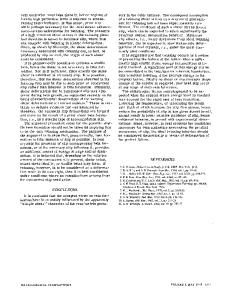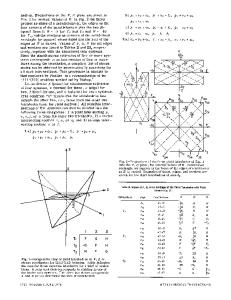Twinning and directional slip as a cause for a strength differential effect
- PDF / 235,388 Bytes
- 2 Pages / 612 x 792 pts (letter) Page_size
- 52 Downloads / 286 Views
Twinning and Directional Slip as a Cause for a Strength Differential Effect W. F. HOSFORD AND T. J. ALLEN
p r e s s i v e yield s t r e s s e s will differ if the i n t e r n a l s h e a r m e c h a n i s m of p l a s t i c d e f o r m a t i o n is s e n s i t i v e to the sign of the s h e a r s t r e s s . For e x a m p l e , t w i n n i n g in a n fcc m e t a l o c c u r s by {111} (119) s h e a r , but not b y the r e v e r s e {111} ( i i 2 ) s h e a r . For s o m e bcc m e t a l s i n cluding i r o n e a s i e r slip has b e e n r e p o r t e d in the f o r ward {112} ( i i l ) twinning d i r e c t i o n than in the opposite d i r e c t i o n . 8 It is c l e a r that such d i r e c t i o n a l s h e a r would lead to a d i f f e r e n c e b e t w e e n t e n s i l e and c o m p r e s s i v e yield s t r e n g t h s in s i n g l e c r y s t a l s or t e x t u r e d p o l y c r y s t a l s . Although it m a y not be so obvious, it is a l s o t r u e that d i r e c t i o n a l s h e a r will c a u s e an S-D effect in randomly oriented polycrystals. A p r e s s u r e - i n s e n s i t i v e m a t e r i a l which d e f o r m s by a r e v e r s i b l e s h e a r m e c h a n i s m , whose o p e r a t i o n d e pends only on the magnitude (not the sign) of the r e solved s h e a r s t r e s s , can have no S-D effect. The yield locus is r e p r e s e n t e d in p r i n c i p a l s t r e s s space b y a c y l i n d e r of sixfold r o t a t i o n a l s y m m e t r y . The T r e s c a , yon Mises, and other p o s t u l a t e d p r e s s u r e - i n s e n s i t i v e , i s o t r o p i c yield c r i t e r i a have such s y m m e t r y . On the other hand, i s o t r o p y r e a l l y r e q u i r e s only that the yield locus have t h r e e f o l d r o t a t i o n a l s y m m e t r y in p r i n c i p a l s t r e s s space.* *Sincethe yieldlocuscan neverbe outwardlyconcave,the maximumpossible differencebetweentensileand compressiveyieldstressesis a factor of two. This correspondsto the yieldlocusbeinga prismof triangularcrosssectionin principal stress space. Chin e t a l . 7 a n a l y z e d d e f o r m a t i o n b y m i x e d slip and twinning in fcc c r y s t a l s . T h e i r r e s u l t s i n d i c a t e that for d e f o r m a t i o n b y twinning alone, the yield s t r e s s in u n i a x t a l t e n s i o n should be about 25 pet lower than that in u n i a x i a l c o m p r e s s i o n f l The effect is j u s t the oppo- ' site for bcc twinning. With m i x e d slip and twinning the d i f f e r e n c e s would be s m a l l e r but of the s a m e sign. The p r e s e n t work extends the c a l c u l a t i o n s to other f o r m s of loading. The yield locus is c a l c u l a t e d for r a n d o m l y o r i e n t e d fcc m e t a l s d e f o r m i n g s o l e l y by {111} (11~.)twinning. The r e s u l t s a r e a l s o a p p l i c a b l e , with changed signs, to bcc m e t a l s d e f o r m i n g by {112} ( I I 1 ) twinning. The method of c a l c u l a t i o n is s i m i l a r to that used by Bishop and Hill for fcc m e t a
Data Loading...











